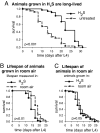Hydrogen sulfide increases thermotolerance and lifespan in Caenorhabditis elegans
- PMID: 18077331
- PMCID: PMC2154480
- DOI: 10.1073/pnas.0710191104
Hydrogen sulfide increases thermotolerance and lifespan in Caenorhabditis elegans
Abstract
Hydrogen sulfide (H(2)S) is naturally produced in animal cells. Exogenous H(2)S has been shown to effect physiological changes that improve the capacity of mammals to survive in otherwise lethal conditions. However, the mechanisms required for such alterations are unknown. We investigated the physiological response of Caenorhabditis elegans to H(2)S to elucidate the molecular mechanisms of H(2)S action. Here we show that nematodes exposed to H(2)S are apparently healthy and do not exhibit phenotypes consistent with metabolic inhibition. Instead, animals exposed to H(2)S are thermotolerant and long-lived. These phenotypes require SIR-2.1 activity but are genetically independent of the insulin signaling pathway, mitochondrial dysfunction, and caloric restriction. These studies suggest that SIR-2.1 activity may translate environmental change into physiological alterations that improve survival. It is interesting to consider the possibility that the mechanisms by which H(2)S increases thermotolerance and lifespan in nematodes are conserved and that studies using C. elegans may help explain the beneficial effects observed in mammals exposed to H(2)S.
Conflict of interest statement
Conflict of interest statement: The authors acknowledge a potential conflict of interest in that both authors are named as inventors on at least one patent that was licensed to a private company, founded by Mark Roth, to commercialize this technology.
Figures




References
-
- Fenchel T, Finlay BJ. Ecology and Evolution in Anoxic Worlds. Oxford: Oxford Univ Press; 1995.
-
- Krauth-Siegel RL, Jockers-Scherubl MC, Becker K, Schirmer RH. Biochem Soc Trans. 1989;17:315–317. - PubMed
-
- Lowicka E, Beltowski J. Pharmacol Rep. 2007;59:4–24. - PubMed
-
- Stipanuk MH. Ann Rev Nutrition. 2004;24:539–577. - PubMed
Publication types
MeSH terms
Substances
Grants and funding
LinkOut - more resources
Full Text Sources
Other Literature Sources

